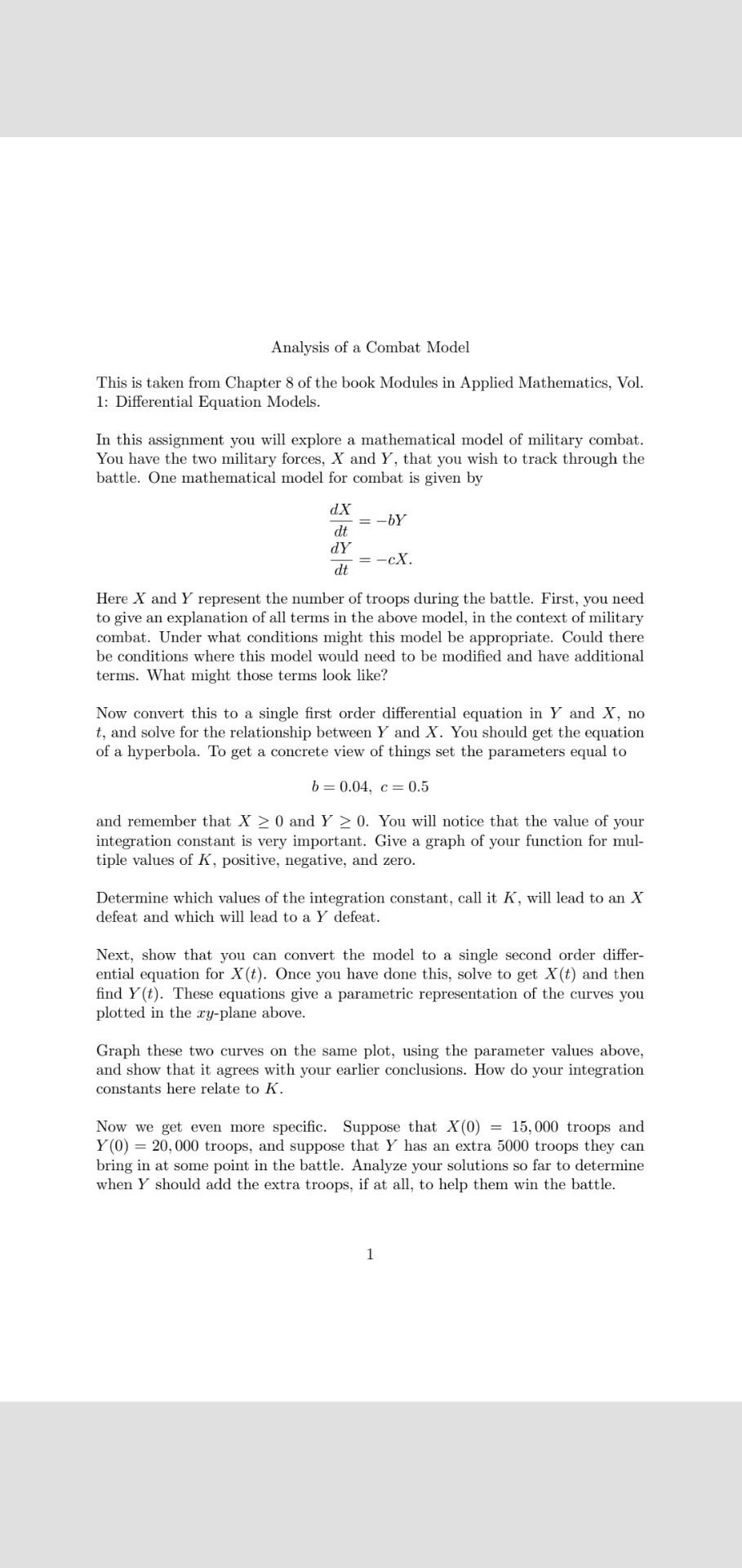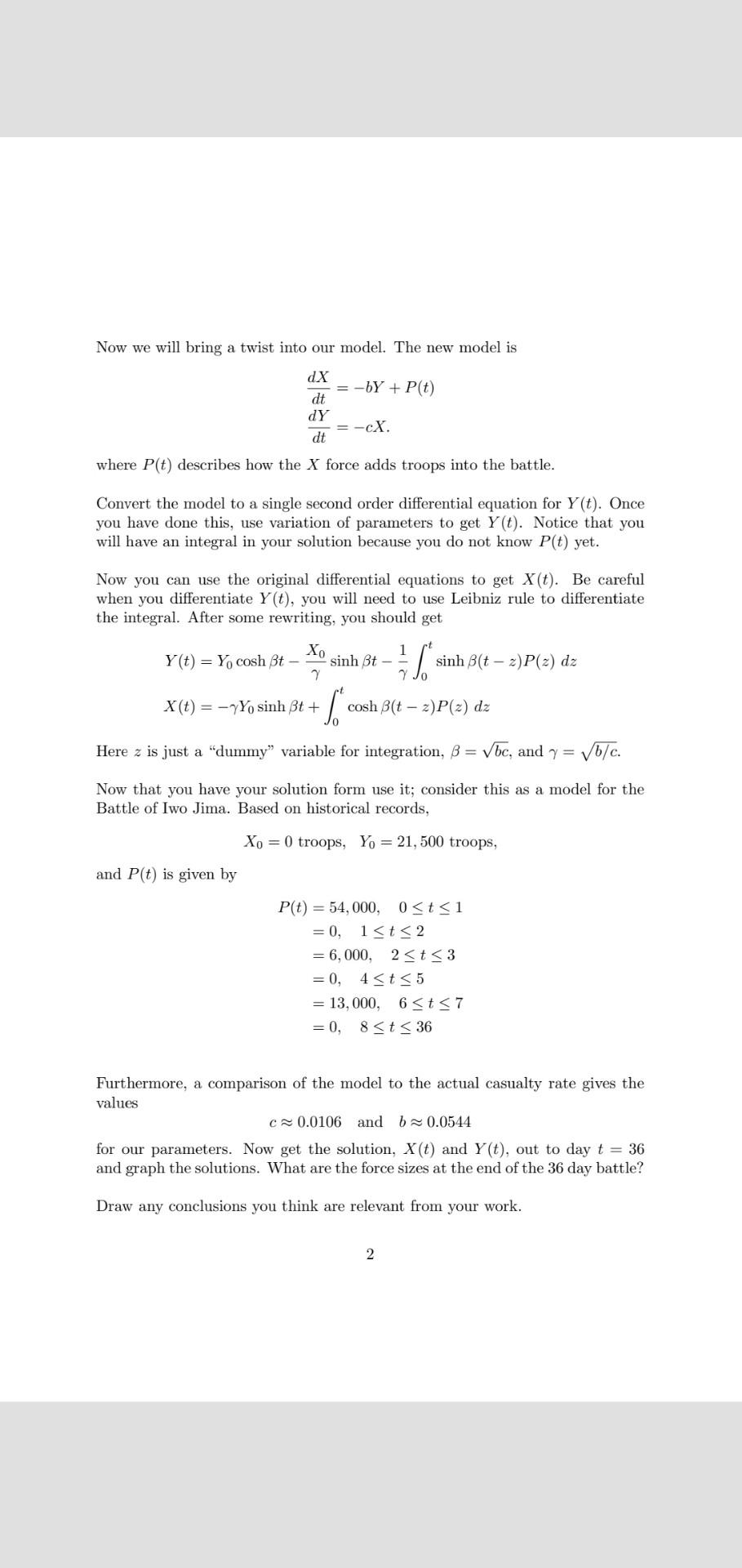Answered step by step
Verified Expert Solution
Question
1 Approved Answer
it's a writing assignment. I don't even know where to start. I can write but don't know the works Analysis of a Combat Model This


it's a writing assignment. I don't even know where to start. I can write but don't know the works
Analysis of a Combat Model This is taken from Chapter 8 of the book Modules in Applied Mathematics, Vol. 1: Differential Equation Models. In this assignment you will explore a mathematical model of military combat. You have the two military forces, X and Y, that you wish to track through the battle. One mathematical model for combat is given by dX = -6Y dt dY = -cX. dt Here X and Y represent the number of troops during the battle. First, you need to give an explanation of all terms in the above model, in the context of military combat. Under what conditions might this model be appropriate. Could there be conditions where this model would need to be modified and have additional terms. What might those terms look like? Now convert this to a single first order differential equation in Y and X, no t, and solve for the relationship between Y and X. You should get the equation of a hyperbola. To get a concrete view of things set the parameters equal to b=0.04, c= 0.5 and remember that X > 0 and Y > 0. You will notice that the value of your integration constant is very important. Give a graph of your function for mul- tiple values of K, positive, negative, and zero. Determine which values of the integration constant, call it K, will lead to an X defeat and which will lead to a Y defeat. Next, show that you can convert the model to a single second order differ- ential equation for X(t). Once you have done this, solve to get X(t) and then find Y(t). These equations give a parametric representation of the curves you plotted in the xy-plane above. Graph these two curves on the same plot, using the parameter values above, and show that it agrees with your earlier conclusions. How do your integration constants here relate to K. Now we get even more specific. Suppose that X(0) = 15,000 troops and Y(0) = 20,000 troops, and suppose that Y has an extra 5000 troops they can bring in at some point in the battle. Analyze your solutions so far to determine when Y should add the extra troops, if at all, to help them win the battle. 1 Now we will bring a twist into our model. The new model is dX = -bY + P(t) dt dY = -cX. dt where P(t) describes how the X force adds troops into the battle. Convert the model to a single second order differential equation for Y (t). Once you have done this, use variation of parameters to get y(t). Notice that you will have an integral in your solution because you do not know P(t) yet. Now you can use the original differential equations to get X(t). Be careful when you differentiate Y(t), you will need to use Leibniz rule to differentiate the integral. After some rewriting, you should get Xo Y(t) = Yo cosh Bt - sinh 3t - sinh Bt - =)P(3) da 7 X(t) = - Y% sinh 3t+. So cosh Bt - 2)P(2) dz Here z is just a "dummy variable for integration, B = Vbc, and 7 = /c. Now that you have your solution form use it; consider this as a model for the Battle of Iwo Jima. Based on historical records, Xo = 0 troops, Yo = 21,500 troops, and P(t) is given by P(t) = 54,000,0Step by Step Solution
There are 3 Steps involved in it
Step: 1

Get Instant Access to Expert-Tailored Solutions
See step-by-step solutions with expert insights and AI powered tools for academic success
Step: 2

Step: 3

Ace Your Homework with AI
Get the answers you need in no time with our AI-driven, step-by-step assistance
Get Started


